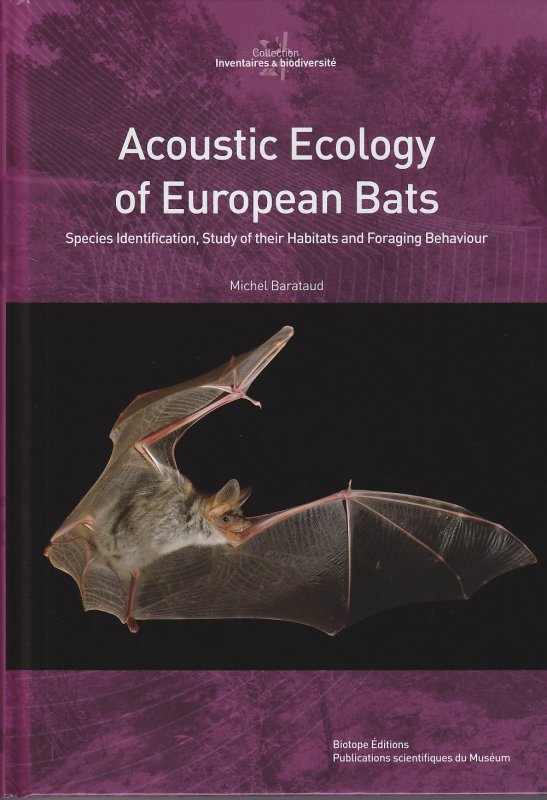
Publisher: Biotope Éditions, Mèze ; Muséum national d'Histoire naturelle, Paris (Inventaires & biodiversité series)
Publication Year: 2015
Binding: 2
Page Count: 352
ISBN Number: 978-2-36662-144-0
Price: £44.99
Acoustic Ecology of European Bats: Species Identification, Study of their Habitats and Foraging Behaviour
As a group, bats are challenging to monitor because most are nocturnal, wide-ranging and can be difficult to identify.
Historically the monitoring of bats in temperate regions has focused on intensive (site-based) visual counts at volunteer-selected winter or summer. There is considerable value in these approaches, but it is difficult to confidently infer from these what is happening at a wider population level, which has been my main interest in bats.
With developments in bat detectors, particularly passive detectors which are left outside to automatically trigger and record any bats that fly past, there is the potential to provide representative acoustic monitoring of bat species distribution and activity as a measure of relative abundance.
Whilst software for semi-automating the analysis of sound files is available and can save considerable time in helping to assign recordings to species as a first analyses, acoustic identification using these approaches is far from perfect for many species.
For this reason, having a clear understanding of how bats calls vary and how far to push identification is essential. Acoustic Ecology of European Bats is the result of 25 years of research by the author in the field of acoustic detection, and was first published in French in 2012.
Despite having a very poor understanding of French, I have been using this book and translating sections where needed since this book first came out, so I am extremely pleased that this book has been published in English.
The introduction summarises the basis of biological sonar and gives an overview of the technologies used to convert ultrasound into audible frequencies.
The identification criteria for 34 European bat species (and covered all British bats) are given in detail, with an entire chapter devoted to the methodology of the acoustic study of their foraging habitats.
Acoustic Ecology of European Bats focuses on the concept of acoustic ecology, illustrated with many examples. This concept explains how the acoustic behaviour of a bat sheds light on its flight environment, its activity, and diet, contributing in all cases to improving the reliability of species identification.
A DVD is included with Acoustic Ecology of European Bats, which comprises over 300 sound sequences (in both heterodyne and x10 time expansion formats) collected from formally identified individuals flying in natural conditions, which I have found extremely useful.
It also includes figures in .xls format, comparing important call parameters for helping in the identification of all bat species. Acoustic Ecology of European Bats contains a wealth of as yet unpublished information indispensable to amateur naturalists and professionals involved in the management of protected areas or in environmental impact studies.
This is the most extensive reference on the acoustic identification of European bats. Whilst I think that everyone working on bats should have a copy of this book, for readers wanting a simpler introduction to acoustic identification of British bats, I would also recommend British Bat Calls, A Guide to Species Identification by Jon Russ.
Book reviewed by Stuart Newson
Buy this book




Share this page